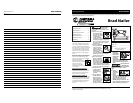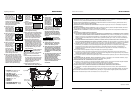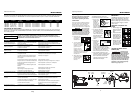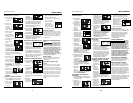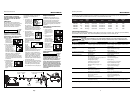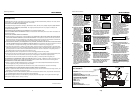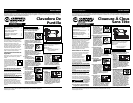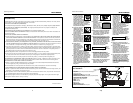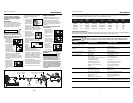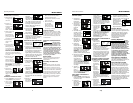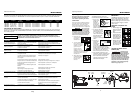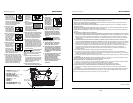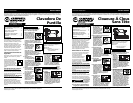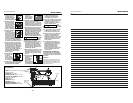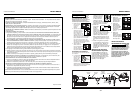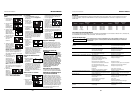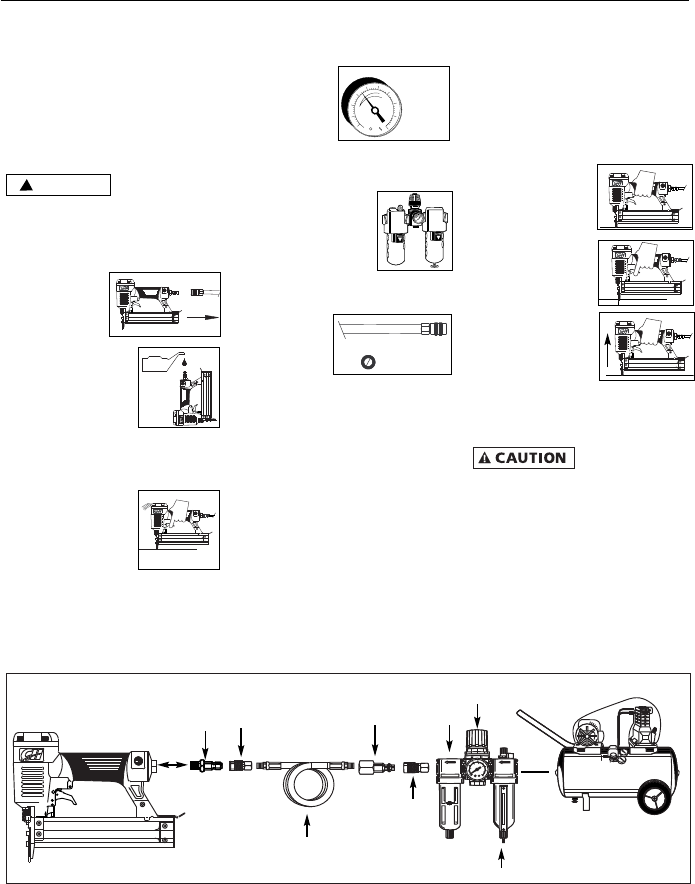
3
Operating The Nailer
Read this manual and understand
all safety warnings and instruc-
tions before operating the nailer.
LUBRICATION
This nailer requires lubrication before
using the nailer for the first time and
before each use. If an inline oiler is
used, manual lubrication through the
air inlet is not required on a daily basis.
The work surface
can become dam-
aged by excessive lubrication. Proper
lubrication is the owner’s responsibil-
ity. Failure to lubricate the nailer prop-
erly will dramatically shorten the life
of the nailer and void the warranty.
1. Disconnect the
air supply from
the nailer to
add lubricant.
2. Turn the nailer so
the air inlet is facing
up. Place 4-5 drops
of 30 W non-deter-
gent oil into air
inlet. Do not use
detergent oils, oil
additives, or air tool oils. Air tool
oils contain solvents which will
damage the nailer's internal
components.
3. After adding oil, run
nailer briefly. Wipe
off any excess oil
from the cap
exhaust.
!
NOTICE
Sequential Trip Safety
Mechanism
The NB0030 is equipped with a sequen-
tial trip safety mechanism. When the
operator depresses the Work Contact
Element (WCE) against the work surface
and then pulls the trigger, a fastener
will be driven.
OPERATING A SEQUENTIAL TRIP
NAILER
1. Release trigger and
place nose of tool
against work sur-
face.
2. Depress the Work
Contact Element
(WCE) against the
work surface and
pull the trigger to
drive a fastener.
3. Release the trigger
and lift the tool
from the work sur-
face after each fas-
tener is driven.
CHECKING THE WORK CONTACT
ELEMENT (WCE)
Check the opera-
tion of the Work
Contact Element (WCE) trip mechanism
before each use. The WCE must move
freely without binding through its
entire travel distance. The WCE spring
must return the WCE to its fully extend-
ed position after being depressed. Do
not operate the nailer if the WCE trip
mechanism is not operating properly.
Personal injury may occur.
RECOMMENDED HOOKUP
The illustration below shows the
recommended hookup for the nailer.
1. The air com-
pressor must
be able to
maintain a
minimum of
50 psi when
the nailer is being used. An inade-
quate air supply can cause a loss of
power and inconsistent driving.
2. An oiler can be used
to provide oil circula-
tion through the nail-
er. A filter can be
used to remove liquid
and solid impurities
which can rust or
“gum up” internal parts of the
nailer.
3. Use 3/8” air
hoses with a
minimum
working pres-
sure of 150
psi. Use 1/2” air hoses for 50’ run or
longer. For better performance,
install a 3/8” quick plug (1/4” NPT
threads) with an inside diameter of
.315" (8mm) on the nailer and a
3/8” quick coupler on the air hose.
4. Use a pressure regulator on the
compressor, with an operating pres-
sure of 0 -125 psi. A pressure regu-
lator is required to control the
operating pressure of the nailer
between 50 and 100 psi.
Recommended Hookup
OILOIL
Quick
Plug
Quick
Coupler
Air
Hose
Quick Plug
(Optional)
Quick
Coupler
(Optional)
Oiler
Regulator
Filter
150 PSI WP
3/8” I.D.
50 psi
Min.
100 psi
Max.
Model NB0030
Operating Instructions
Calibre Clavos por Clavos por
Modelo # Longitud
del cuerpo
Acabado Cabeza Unión
línea Caja
FB001600 15,9mm (5/8”) Calibre 18 Galvanizado De puntilla/Café Adhesivo 100 5000
FB002000 19,1mm (3/4”) Calibre 18 Galvanizado De puntilla/Café Adhesivo 100 5000
FB002500 25,4mm (1”) Calibre 18 Galvanizado De puntilla/Café Adhesivo 100 5000
FB003000 31,8mm (1
1
⁄
4”) Calibre 18 Galvanizado De puntilla/Café Adhesivo 100 5000
Clavos
Estos clavos para acabado de Campbell Hausfeld los puede comprar en su tienda más cercana. Si necesita ayuda para encontrar
un artículo, comuníquese al 1-800-543-6400. Los clavos de Campbell Hausfeld cumplen o exceden el estándar ASTM F1667
Información de intercambio
Los clavos usados con la clavadora para acabado NB0030 de Campbell Hausfeld también se pueden usar con las clavadoras :
Bostitch T31-1, T29-30, BT-35, Duofast BB4440, Hitachi NT45A , Paslode 2138-F18 , Porter Cable BN125, BN200, Sears 18309, y
Senco SLP20, LS2, LS5.
Guía de Diagnóstico de Averías
Deje de usar la clavadora inmediatamente si alguno de los si guientes problemas ocurre.
repuestos. Podría ocasionarle heridas graves. Cualquier reparación o reemplazo de piezas los
debe hacer un técnico calificado personal de un centro autorizado de servicio.
!
ADVERTENCIA
Problema Causa Solución
5-Sp
Modelo NB0030
Manual de Instrucciones
Debe reemplazar los anillos en O & chequear el fun-
cionamiento del elemento de funcionamiento al contacto
Debe apretar los tornillos
Debe reemplazar los anillos en O
Debe reemplazar la defensa
Debe apretar los tornillos
Debe reemplazar la defensa
Debe reemplazar la defensa
Debe limpiar el canal del sistema de impulso
Debe limpiar el cargador
Debe reemplazar el resorte
Chequée las conexiones, la manguera o el compresor
Debe reemplazar los anillos en O. Lubríquelos.
Debe reemplazar los anillos en O
Debe apretar los tornillos y las conexiones
Debe reemplazar el empaque
Necesita lubricar la clavador
Debe reemplazar el resorte
Debe reemplazar las partes internas dañadas
Debe reemplazar la guía
Debe usar los clavos recomendados para esta clavadora
Reemplácelos con clavos en buenas condiciones
Debe apretar los tornillos
Debe reemplazar el mecanismo de impulse de clavos
Vea las instrucciones de cómo cargar/descargar la
clavadora
Debe reemplazar los anillos en O o los sellos
Hay una fuga de aire en el
área de la válvula del gatillo
Hay una fuga de aire entre la
cubierta y la boquilla
Hay una fuga de aire entre la
cubierta y la tapa
La clavadora deja de clavar un
clavo
La clavadora funciona lenta-
mente o pierde su potencia
Hay clavos atascados en la
clavadora
Hay una fuga de aire en el
vástago de la válvula del gatillo
Los anillos en O de la cubierta de la válvula del
gatillo están dañados
Los tornillos de la cubierta están flojos
Los anillos en O están dañados
La defensa está dañada
Los tornillos están flojos
El empaque está dañado
La defensa está desgastada
La boquilla está sucia
La suciedad o daños evitan el desplazamiento
libre de los clavos o el mecanismo de impulso
en el cargador
El resorte del mecanismo de impulso está dañado
El flujo de aire hacia la clavadora es inadecuado
El anillo en O del pistón está desgastado o le
falta lubricación
Los anillos en O de la válvula del gatillo están
dañados
Hay fugas de aire
Hay una fuga en el empaque de la tapa
La clavadora no está bien lubricada
El resorte de la tapa del cilindro está roto
El orificio de salida de la tapa está obstruído
La guía del mecanismo de impulso está desgastada
Los clavos no son del tamaño adecuado.
Los clavos están doblados
Los tornillos del cargador o de la boquilla están flojos
El mecanismo de impulso está dañado
Los clavos están mal colocados
Los anillos en O o los sellos están dañados



